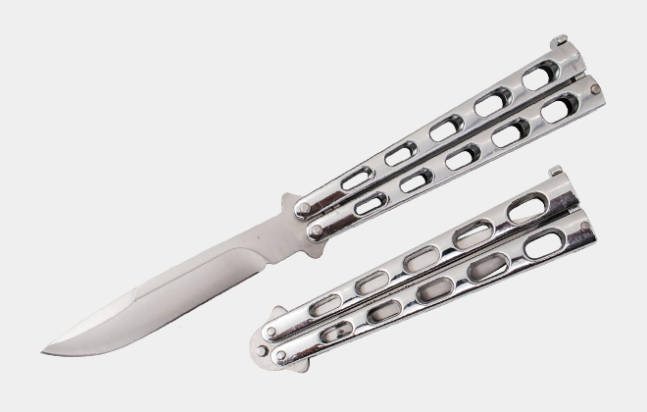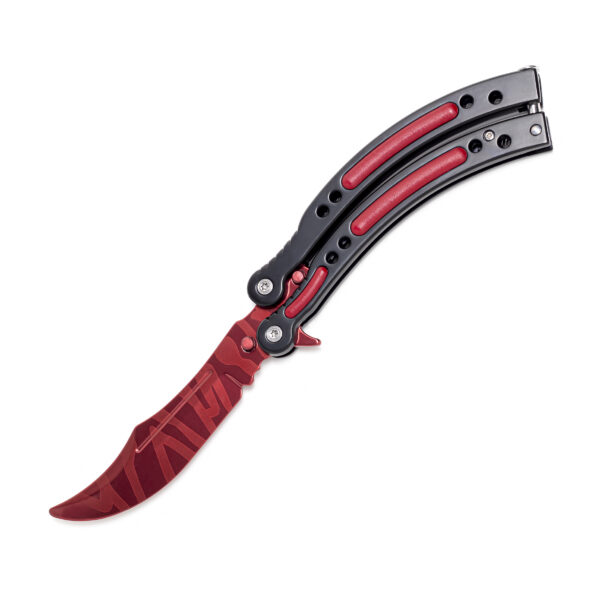Butterfly knives, also known as balisongs, have captivated collectors for decades. Butterfly knives are renowned among knife enthusiasts and mainstream media because to its unusual design and remarkable flipping techniques.
This guide covers butterfly knives’ history, manufacturing, legality, and more. This page covers butterfly knives for beginners and experts.
What is a Butterfly Knife?
Butterfly, or balisong, knives have handles that revolve around the blade’s pivot. The knife can be discharged or concealed with a smooth flip of the counter-rotating handles. Butterfly knives are famous among knife aficionados and collectors because of their unusual mechanism.
The History of Butterfly Knives

Butterfly knives originated in the Philippines as self-defense and utilitarian implements. The Filipino word “balisong” means “broken horn,” referring to early butterfly knife handles constructed of animal horns.
Butterfly knives were likely invented in the late 19th century. Butterfly knives, formerly used by farmers and fishermen, became popular among martial artists and knife lovers worldwide.
Construction and Design
Butterfly knives have several important parts that affect its usefulness and appearance. Let’s examine a butterfly knife’s primary parts:
Blade: Butterfly knives can have tanto, spear-point, or drop-point blades. Stainless steel makes it corrosion-resistant and durable.
Handles: Butterfly knife handles distinguish it. They are typically constructed of stainless steel, aluminium, titanium, or exotic materials like carbon fibre or G-10. The handles are ergonomically constructed for flipping.
Latch: Butterfly knives include a latch or locking mechanism to keep the handles closed and open. The clasp prevents knife-handling accidents by opening and shutting.
Pivot: Handles rotate around the pivot. Flipping safely and efficiently requires a smooth and strong pivot mechanism.
Legality of Butterfly Knives

Butterfly knives are not legal anywhere. Butterfly knives are permitted in many nations, but some ban them. Before buying a butterfly knife, check your local laws. Butterfly knife legality considerations:
USA: Butterfly knife laws differ by state. California and New York ban butterfly knives. Florida, Texas, and other states allow butterfly knives with particular blade lengths or concealed weapons permits. Before buying a butterfly knife, check your state’s laws.
United Kingdom: Butterfly knives are offensive weapons in the UK and forbidden to sell, buy, carry, or import. Butterfly knives are illegal. Butterfly knives have live blades and trainers.
Australia: Australia prohibits butterfly knives. Butterfly knives are banned in most states. Butterfly knives can be fined or imprisoned if owned, sold, imported, or bought.
Canada: Butterfly knives are authorised in some provinces and territories. Butterfly knives are banned or restricted in several areas. To comply, check your province’s laws.
Different Types of Butterfly Knives

Butterfly knives vary in style and appearance. Common butterfly knives include:
Traditional Butterfly Knife: The traditional butterfly knife has symmetrical handles with the blade sandwiched between them. They have a latch to lock the handles open and closed.
Tanto Butterfly Knife: Tanto butterfly knives resemble Japanese tanto blades with straight edges and angled points. This design pierces and is strong.
Trainer Butterfly Knife: Trainer butterfly knives, also known as practise balisongs, are used for safe flipping practise. They have blunt or rounded blades to reduce training injuries.
Custom Butterfly Knife: Skilled artisans make customised butterfly knives with attention to detail. These knives have elaborate designs, rich materials, and unusual finishes.
Balisong with Inlays: Inlays on butterfly knife handles give visual appeal and texture. Inlays can be constructed of wood, bone, mother-of-pearl, or metals.
Spring-Latch Butterfly Knife: Spring-latch butterfly knives have a spring-loaded latch mechanism. This device speeds deployment and secures handles.
Pros and Cons of Butterfly Knives
Butterfly knives, like every tool, have pros and cons. Let’s weigh butterfly knives’ pros and cons:
Pros:
Flipping and Manipulation: Butterfly knives are popular with manipulators because of their flipping powers. Pivoting handles enable amazing flipping stunts.
Aesthetics: Butterfly knives are collectible because of their elegant designs and ornate handles. Exotic woods and metals make the handles more attractive.
Compactness: Butterfly knives are folding, making them portable. The handles protect the blade when closed.
Skill Development: Butterfly knife manipulation takes practise. Mastering flipping techniques can be rewarding for aficionados.
Cons:
Safety Concerns: Butterfly knives’ flipping movement and exposed blade demand caution. They are more dangerous than folding knives in untrained hands.
Legality Restrictions: Butterfly knives are illegal in some places. Butterfly knife fans may face legal concerns if butterfly knives are unavailable in their area.
Limited Utility: Butterfly knives are mostly for flipping and manipulating. The knife’s flipping movement and balance may make cutting and slicing difficult.
Skill Requirement: Butterfly knife flipping requires practise. Beginners need patience and practise to flip smoothly and accurately.
How to Flip a Butterfly Knife
Flipping a butterfly knife takes practise, coordination, and knowledge of its mechanics. To avoid mishaps, start cautiously and use suitable practises. Butterfly knife flipping begins with these steps:
Hold the Closed Knife: Grip the butterfly knife firmly with one hand to secure the blade in the grips. To avoid cuts, don’t touch the biting handle’s edge.
Release the clasp: Use your thumb or another finger to release the handle clasp. The handles can spin freely.
Open the Knife: Holding the safe handle, swing the bite handle away from you. This will open the blade from the bite handle.
Flip the Knife: With the knife open, alternatively swing the handles to flip it. Start with easy flips and proceed to harder stunts as you improve.
Practice Safety: Always flip in a safe environment. Avoid doing tricks near others or on surfaces where dropping the knife could hurt someone.
Butterfly Knives in Popular Culture
Butterfly knives have appeared in movies, games, and literature. Their distinctive design and intriguing flipping techniques have made them genre icons. Popular butterfly knives include:
Movies: Action and martial arts films have featured butterfly knives. In “The Replacement Killers,” Chow Yun-fat’s character expertly uses a butterfly knife during fight scenes.
Video Games: Butterfly knives are used in several video games. “Counter” games for players.
Literature: Butterfly knives typically symbolise danger, intrigue, or a character’s expertise in crime novels and thrillers.
Street Performances: Skilled butterfly knife flippers wow audiences with their elaborate feats and routines.
Maintenance and Care
To keep your butterfly knife in excellent shape, follow these steps:
Cleaning: Clean your butterfly knife regularly to eliminate dirt, debris, and moisture. Use a soft cloth or brush to wipe down the blade and handles, or use mild soap and warm water for a more thorough cleaning. Make sure the knife is totally dry before storing it.
Lubrication: Apply a little amount of lubricating oil to the pivot area and other moving elements of the knife to prevent rust and preserve smooth flipping motion. Be careful not to over-lubricate, as excess oil might attract dust and debris.
Tighten Loose Screws: Loose screws might impact your butterfly knife’s flipping action and stability. Check them regularly.
Storage: Keep your butterfly knife in a safe, dry place and use a knife pouch or sheath to protect the blade and handles.
Avoid Harsh Conditions: Extreme temperatures, dampness, and corrosives can harm your butterfly knife’s blade, handles, and pivot mechanism.
Choosing the Right Butterfly Knife
To find the right butterfly knife, examine these factors:
Blade Material: Choose a butterfly knife with a high-quality stainless steel blade for durability, corrosion resistance, and easy maintenance. Consider the blade form and length based on your planned use and personal choice.
Handle Material: Consider the aesthetics, texture, and durability of the handle material, which can be stainless steel, aluminium, titanium, G-10, or carbon fibre.
Pivot Mechanism: For smooth flipping and safety, choose a butterfly knife with superior ball-bearing pivots or bushing systems.
Safety Features: A well-designed latch or locking mechanism locks the handles in both open and closed positions, preventing accidental openings and closings.
pricing Range: Butterfly knives range from affordable to high-end unique designs, so consider quality and pricing when choosing.
Frequently Asked Questions (FAQs)
Butterfly knives—legal?
Before carrying a butterfly knife, check your local laws.
Is a butterfly knife self-defense?
Butterfly knives can be used for self-defense in certain instances, but they are not meant for that purpose. It is best to verify local laws and use legal, self-defense instruments.
Beginner butterfly knives?
Beginners should be cautious and get sufficient training before using butterfly knives.
Can butterfly knives be sharpened?
Butterfly knife blades can be sharpened like any other knife blade, but it’s best to have a professional do it to ensure the blade’s safety.
Butterfly knives: customizable?
Some manufacturers give options for customising handle materials, blade finishes, and even personal engravings. Skilled artisans can also make totally custom butterfly knives with unique designs and features.
How do I keep butterfly knife flipping?
Maintain the knife’s flipping ability by cleaning, lubricating, and tightening screws.
Conclusion
In conclusion, butterfly knives are a fascinating tool that knife enthusiasts love for their flipping abilities and aesthetic appeal.
This article has covered butterfly knives’ definition and origins, legal considerations, types and designs, pros and cons, flipping techniques, popular culture references, maintenance tips, and factors to consider when choosing one.
It’s important to handle butterfly knives responsibly, respectfully, and safely.
